

Michael Albaugh interview
By Scott Stilphen
(2017)
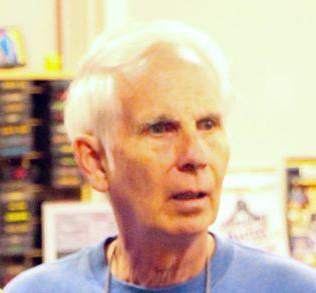
Michael Albaugh had a long and storied career at Atari, starting there in early 1976. By the time he left in 2000, the company had gone through several name changes (Atari, Atari Games, Time-Warner Interactive, Midway Games West), and some of the code he wrote was implemented in countless games from all of them.
Q: You have a A.B. in Computer Science from the University of California, Berkeley. What inspired you to pursue a career in game design? Were there any programmers or games that inspired you?
Michael Albaugh: Nothing so interesting. I needed a job. Well, I needed a job that could potentially use my skills and my C.S. degree, rather than staying a draftsman and PCB designer years after being told I would be "moving up soon". I did play Computer Space in a Sears department store, and BSed about what would today be called a multi-player distributed game, but it was 1974 or so and we never got past sitting around tossing out vague notions and wildly optimistic "plans". This was intended to be something where groups of nerds would build their own nodes, each with a 3-person "crew". Details (maybe, my memory is dim) on request, but as a totally pipe-dream with no plan of ever being commercial, really a footnote, if that.
Q: How did the opportunity to work for Atari come about?
Michael Albaugh: Short answer: Joe DeCuir. Long answer: Stuck in the aforementioned rut, I noticed on a trip to the Santa Clara Valley that there were buildings everywhere with what looked like theatre marquees advertising open technical jobs. That motivated me to dust off my resume, buy a truck (don't want to show up at an interview with helmet-hair), and start dropping applications in the valley. I was so discouraged by the lack of interest (from IBM, Rolm, HP) that I cut it short. Later, I went to visit school-friend Joe in the wilds of Nevada City, and even dropped in on Cyan Engineering, which reminded me of something from The Avengers (Steed and Peel variety). Anyway, I told him my tale of woe and he said that the Coin-Op group at Atari might be needing some people. The rest is history.
Q: You were at Atari from March 1976 to July 2000, over 24 years! From your LinkedIn page, you were the 3rd programmer hired there, and you worked on a multitude of projects including some HW design, project management, game development, and misc. hardware and software infrastructure (drivers, diags, security).
Michael Albaugh: Yes, sort of. There is some debate on the order of programmers #3-#5 in Coin-Op. Dennis Koble may have been hired before me, but started later. Owen Rubin fits in there somewhere too, although I am pretty sure after me. Contrary to web-history, Owen and I, and I believe Dennis, all had CS degrees, so unless a certain Consumer programmer was hidden in a closet... There were programmers in Consumer, like Larry Wagner, but only two in Coin-Op before I reported for duty. Well, there was Larry Bryan, but he was gone by the name-change to Atari, IIRC, and before Atari used microprocessors.
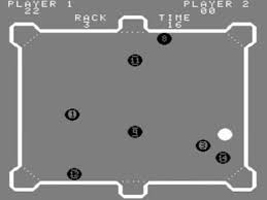
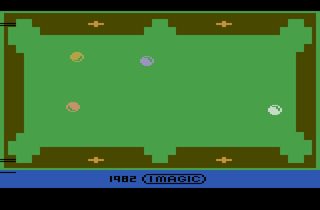
(LEFT) Atari's coin-op Pool Shark; (RIGHT) Imagic's Atari VCS Trick Shot.
Q: Can you talk a bit about each of your games, as far as the inspiration behind it, what the easiest/hardest part of designing each one, the people you worked with on them, etc? Let's start with Pool Shark, which is quite a rare coin-op game.
Michael Albaugh: My very first game assignment. This was a game that I suspect a lot of people wanted to do badly, and did. When the Tank 8 hardware came out and allowed "so many" moving objects, it was time! Or maybe not. We (well, they) had to modify the hardware to display objects that were not basically squares, and that could get close to
each other without exploding. Then I also had to come up with the software part of that mod, sorting the balls in H and V and assigning the right "logical" balls to each "physical". Got that part done, but got wrapped around the axle with the physics, or specifically the transcendentals. OK, mostly ArcTan. Management got pissed off at my slow progress and gave the game to another, "more experienced" programmer who, as far as I can tell, didn't bother to fix anything,
other than dialing up the surface viscosity, making a game that was almost, but not quite, entirely unlike Pool.
I got re-assigned to Boxer... more like freed up to devote more time to it. Well, in truth, most of the time we were always working on more than one game, in various stages, at a time. But being thrown off Pool Shark freed me up to devote my full attention to Boxer. Not that it helped.
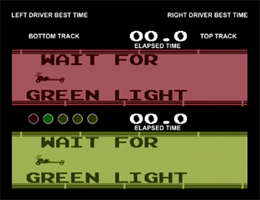
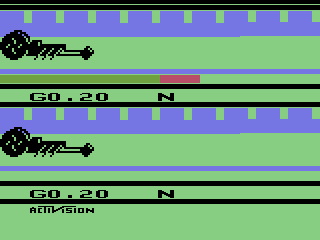
(LEFT) Atari's coin-op Drag Race; (RIGHT) Activision's Atari VCS Dragster.
Q: Drag Race – Great game. Activision later knocked off with their VCS Dragster game. What were your thoughts about that?
Michael Albaugh: Mixed. Activision also did a version of the never-released Boxer.
I noticed Atari's flyer shows the driver ahead of the engine, while both my game and Activision's has the engine forward, which had probably been outlawed by the time Drag Race was released. Having flying metal from a blown engine or supercharger can be a bummer. I believe the graphics had already been decided on by the time I was assigned
to it. I hadn't paid much attention to actual drag racing since maybe 1968, so didn't notice until "too late", but I don't know Activision's excuse.
A more interesting artifact is the "Christmas tree". In three ways:
1) There were fewer lights by the time I was doing Drag Race. Again, didn't catch it.
2) The "tree" is horizontal, because of hardware limitations and the color overlays. Real ones are vertical, with a set of lights for each car, where RED indicates which car broke the beam early.
3) "beep beep beep BOOOOP". As you can imagine, it would be darn hard to hear that over the engines. I added it because some players had trouble paying attention to, or even noticing, the lights.
What is interesting to me is that not only Activision, but many (most?) video driving games from then on used that layout and sound. 'Cargo cult programming'?
The hardest part was dealing with the hardware (only used for that game) while learning this whole game-development job. Dunno what the easiest part was. Hanging out with amazing people while working my butt off (?), but that wasn't particular to this game.
People on the team included Paul Mancuso (tech), Howard Van Jepmond (engineer), and Barney Huang (industrial design). I am doubtless forgetting others.
I believe this was my first exposure to Owen Rubin's fantastic ability to get games to misbehave. He is a savant at software testing by doing things that leave the programmer thinking, "Who would do THAT?"

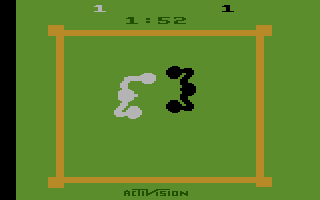
(LEFT) Atari's coin-op Boxer; (RIGHT) Activision's Atari VCS Boxing.
Q: What do you recall of Boxer?
Michael Albaugh: Boxer (Boxing? name changed somewhere in there) started out as part of what some of us saw as a need for a more physical experience, later to manifest in the Football game, whose cabinet was (in my opinion) derived from the Boxer one. I believe Jerry Lichac came up with the
original controller, although it may have been another mechanical designer. Picture the sort of control an R/C model might have, with a twist knob atop a standard analog joystick. Now imagine the "knob" being a pair of handles you could grip, at the ends of a 6-inch or so bar, and that bar atop a shaft that moved in X and Y - three axes. You moved your boxer with the X/Y position, and punched by rotating those handles. Now, imagine someone getting "really into" the game,
and breaking the control in a few minutes. Several revised designs followed, with the last few being variants where the Y axis (forward/back) was removed in favor of a beefier slider, and several software variants to "make it fun" despite the reduced physicality. I believe Ed Logg took a crack at doing Version 14. The rest is non-history.
A nerd-note: This was my first 6502-based game (Pool Shark and Drag Race used the 6800). It also went through a major redesign early on. The first design was by Howard Van Jepmond, who did Drag Race,
Hi-Way, and maybe Stunt Cycle, Outlaw, and Qwak! (the duck-hunt game, not the touch-screen puzzle game that never made it past focus group).
My biggest technical challenge was reading 6 potentiometers whose interface was a "nearly all software" minimal hardware thing, with code the tightest I had ever written.
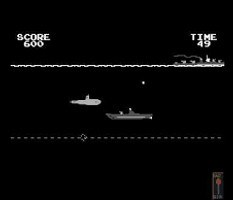
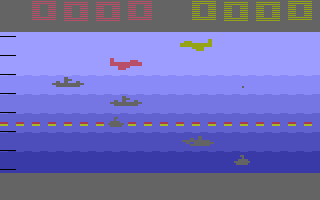
(LEFT) Atari's coin-op Destroyer; (RIGHT) Atari's VCS Canyon Bomber ("Sea Bomber" variation).
Q: Destroyer – a Sea Wolf variant but with a great monitor cardboard bezel.
Michael Albaugh: Not sure I'd agree with the Sea Wolf link, but whatever. Not sure where the idea came from, but we (I?) definitely wanted this to be a Depth Charge game, where one had to not only hit the button at the right time, but set the _depth_ correctly. Unfortunately, someone else (Meadows?) came out with a game named Depth Charge just as we were getting
ready for production. That game was the more typical "bomber game with different graphics", but we had to rename ours and scrap 300 bezels with the (now) "wrong" name. Trivia: The first non-English language on this game was Norwegian.
Shout-outs to (IIRC) Jerry Lichac for that control, and to (IIRC) Rich Patak for the ping-bang-boom audio, also used in Wolf Pack. Also to Steve Ehret, technician and some graphics.
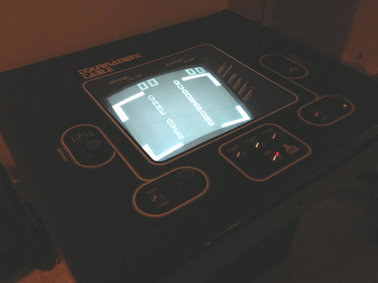 Q: You mentioned programming some kernels for the VCS-based coin-op Tournament Table...
Q: You mentioned programming some kernels for the VCS-based coin-op Tournament Table...
Michael Albaugh: More like "did some Proof of Concepts". I have no idea if any of my actual code got into the shipped product. Maybe some boilerplate diags.
Q: I recently owned 2 Atari TT machines and was surprised to see how similar the board was to a stock Atari VCS. I have a photo of the pcb on this page. It’s basically the same, except for having 2 RIOT chips. Why was this? I’m guessing that even though the VCS
could support up to 4 paddles, the extra switches on the TT machine required the 2nd chip to support them.
Michael Albaugh: I have (or had, as I can't seem to find it) the TT development board. This was an actual VCS board with a wire-wrapped daughter-board and air-wired jumpers. It also had a 40-pin 6502, as using the HP clip-on analyzer was easier/possible. What (smaller) CPU is in your TT board? I believe the reason for 2
RIOTS was more like the extra RAM, and possibly a second timer to make the gameplay software easier. If the production TT has a 6507, then "never mind". But it's interesting that coin-op games of the day often had hardware that could only be touched during VBlank, while the TIA was required to be touched in active video. Without knowing what CPU the production boards had, I'm in the dark.
Q: The CPU chip in the TT is the same as in the VCS - 6507. Did the TT pcb produce a color signal? The cabinet had a b&w monitor, but I was curious if color output was possible, or was the relevant hardware stripped out? And would it be possible for a VCS to run any of the TT games?
Michael Albaugh: More like color was "not added in". The TIA "spoke NTSC" natively, so to use an RGB monitor, they would have had to include an NTSC decoder, or hack consumer-grade TVs like in the Pong days. Since the major point of TT was (IIRC) to make a cheap "cocktail table" game for casual locations, adding cost would be a no-no.
As for compatibility, probably not. TT did not map pages 0 and 1 to the same space, and used the RAM in the second RIOT as a separate stack. This meant several things, among them that the stunts that "normal" VCS programmers could use by pointing the stack at TIA register would not work. So no VCS code on TT. The issue with TT code on VCS would be a combination of possible missing switches (e.g. coin and option switches), and I'd guess that Tom Hogg (who did the actual Tournament Table code) would have used the extra RAM.
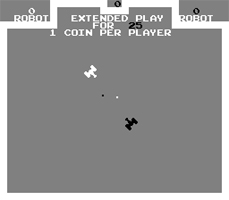 Q: Ultra Tank – the last variant of the original Tank games and the last one under the Kee Games name.
Q: Ultra Tank – the last variant of the original Tank games and the last one under the Kee Games name.
Michael Albaugh: The most interesting things I can say about Ultra Tank are:
1) The AI was indeed primitive. Its behavior reminded me of a housefly. But it "met expectations".
2) There is a bug, or "mis-feature", in the attract mode when on free play. I found out about it when I saw an Ultra Tank on display and was curious about it, whereupon the owner identified himself and mentioned the bug. I told him I'd fix it, but I can't find my EPROM programmer and he's in no hurry, so...
3) I got another bug report that "If one player tried to drive through a wall, and the other came up behind and pushed, the first tank would get partway into the wall and stick. Didn't fix that one.
I believe the crew included Joe Coddington and Dave Stubben.
Q: Wolf Pack – unreleased Sea Wolf variant. A recent book about Atari claims you worked on a dedicated circuit that created a “wake” effect from the torpedoes onscreen in the game, and mentions the effect was similar to another game in development called HydroPlane (“Sprint on water”).
The book also mentioned the game was cancelled by Gene Lipkin because he didn’t like boat games, although in my conversation with Dennis Koble, he mentioned working on the game but that it had some mechanical problems that were never solved, which is why it wasn’t released.
Michael Albaugh: I had very little to do with Wolf Pack, other than admiring it as it was being developed in an adjacent work area. Dave Sherman did the wake circuit for Wolf Pack, essentially a triangle generator modulated by pseudo-random noise to make it sparkle. HydroPlane used a variant with a bit-map rather than a triangle
generator, to allow more flexibility. Of course, we could not afford a full-screen bitmap, so there were two small (32x32?) bitmaps, one for each boat, each with a square "window". We got a patent for that. But, as mentioned, Gene hated boat games. Also, players did not get into the physics of the boats or the pylons rather than a track, and if we went back to more car/track-like play, what's the point?
There is truth to "Gene Lipkin didn't like boat games". He also didn't like various other things and was prone to snap judgment cancellations. That's one reason games often had a "Lipkin switch" to make them act up or shut down, to lend authority to the programmer saying, "Sorry, Gene, it's broken at the moment so we can't show it to you".
Q: After watching a video of it, I would have thought the wake effect was something created in software.
Michael Albaugh: The basic shape of the wake was drawn into the bitmap by software. You may overestimate the abilities for a 750khz 6502. Perhaps too much time marveling at what VCS programmers were able to do?
Seriously, Sprint hardware ran at 750kHz, while the VCS ran at 1.2MHz. Also, the "working RAM" on Sprint was 96 bytes. The video was more capable, for sure, with game-specific hardware assists, a luxury we had because we could custom-fit hardware to the game, and vice-versa.
I am bummed to hear only voice. I could have sworn Wolf Pack used the "ping-bang-boom" sounds. So much for my memory.
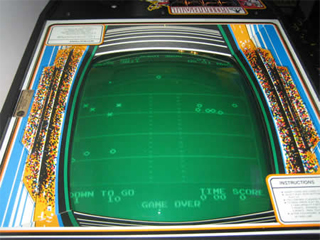 Q: Atari Football – One of my favorite games.
The success of this spawned the creation of other sports games (Baseball,
Basketball, and Soccer).
This article
claims Steve Bristow conceived of the game in 1975 under the early name, "X's and O's",
and that he later abandoned it to work on Tank, with yourself, Dave
Stubben, and Lyle Rains taking over the project.
Q: Atari Football – One of my favorite games.
The success of this spawned the creation of other sports games (Baseball,
Basketball, and Soccer).
This article
claims Steve Bristow conceived of the game in 1975 under the early name, "X's and O's",
and that he later abandoned it to work on Tank, with yourself, Dave
Stubben, and Lyle Rains taking over the project.
Michael Albaugh: This was a case of "We Have the Technology (now)". Several people at Atari had wanted to do this game for a while, but our existing (processor-based) hardware could not handle more than 4 moving objects (Indy 800 had a separate board per car, IIRC. Before my time). The Tank 8
hardware was better, but had issues when objects got close to each other (ala Pool Shark). Then Lyle Rains had an idea that Dave Stubben "reduced to practice" as MOC-16 (Motion Object Control, 16 objects). As an aside, we tended to use terms like "dot" (rather than pixel), stamp (typically 8x8 dots), and MO (Motion Object) rather than "sprite" which as far as I know came from T.I. At least I first saw it in reference to their graphics chip (used in the TI-99 home
computers, the MSX systems, and some add-in Apple ][ cards, probably among others). Anyway, MOC-16 and its descendants became sort of a standard platform, both for Atari games and several Japanese companies.
I wrote the interpreter for the scripts that drove the individual players, but
Ed Logg did most of the script programming/tuning (what folks now call the "AI"
for the NPCs), which
were originally proposed by Steve Bristow, Dave Stubben, and Lyle Rains.
Although I was not in on the original proposal (arriving in
1976), I have to wonder about the "Xs and Os" working title. When pitched
to me, the working title was "Monster Man", apparently an existing football
term. The players were to look like people (well, football players :-),
but I felt, and once I had demonstrated, that was difficult to do well in 8x8
pixels, we switched to Xs and Os. The Player-controlled ones were larger,
and since 'O' for offense allowed the ball to be seen better when carried, it
won the day. I did add the part where the teams leave the field and are
replaced (Offense<->Defense> to emphasize the turnover.
That article also implies that the scrimmage line marker was introduced with
4-player Football, whereas it (and the first-down marker) were in from pretty
much the start. Those markers are all the one leftover motion object (7 players
on two teams + ball + the markers) with horizontal and vertical position changed
as the beam proceeds down the screen.
You may have noticed that there are actually 19 MOs on the Football screen: 14 players, 1 ball, two markers for line of scrimmage, and two markers for first down). Those last four are actually one object, as they never appear on the same horizontal line, so the software can change parameters as the scan progresses. Many Japanese variants had hardware to automate this re-use, as does the Famicom (NES), which can only display four objects per line, IIRC.
A datapoint: When we introduced Football at the AMOA (maybe just called MOA at the time), there was a small booth very near ours (maybe Meadows?) with a game that looked a lot like the original version (pixel player, not X and O) of our game. Surprise! Booth also contained a former Atari Marketing guy who had left before the change. He, of course, maintained that the similarity was accidental (what Star Trek would call "Parallel Evolution").
Q:
In some two-player models built in late 1978 and early 1979, there was a bug
that would allow the QB to throw a pass after crossing the line of scrimmage,
then going back behind it. When the QB crossed scrimmage, all the defending X
players would leave their receivers open as they pursued the run, making long
completions easy.
Michael Albaugh:
The bug about the QB being able to duck back and pass after crossing the line of scrimmage was a typo, checking the "is past the line" flag rather than the "has passed the line" flag. A literally one-bit patch, which was sent out on Atari's dime, so if you find a game that still has it, somebody was lax with their updates.
The path of a passed ball is odd in the extreme. Mindful of the Pool Shark debacle, I threw in a very crude "line drawing" algorithm, then later went back to "do it right", but players preferred the "broken" version, so that's what shipped.
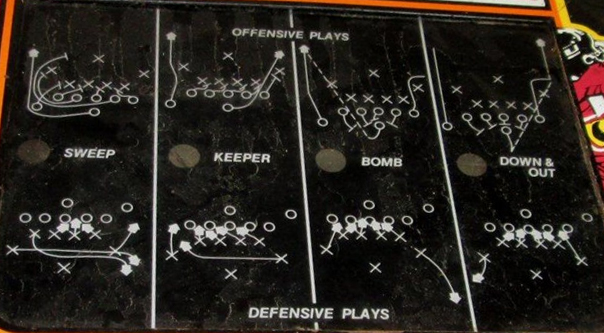

(LEFT) Original Atari Football coin-op play panel; (RIGHT) Revised panel with new plays.
Q: I only recently learned a revision was made to Atari Football to include a punt option! Do you recall anything about that?
Michael Albaugh: There were changes in the plays during development, but don't really remember. What I do remember is I made three changes after the start of production. I already mentioned the bug-fix for the QB passing after having crossed the line of
scrimmage. That was sent out free. Another was to make an even more-expensive price available in the price options. That we charged for. The last one I remember was also a bug fix, thus free, but I cannot remember what it was. Fortuitously, each bug "lived" in different
(one of the three) 2K ROMs. It was a little work to do bug-fixes that did not alter any "visible" entry points of data table addresses, so the three changes were independent. That is, you
could theoretically have any of eight versions of the game. The pass fix was, as I mentioned, literally a single bit. The price change was likewise a change only to the contents, not the length, of one array. I dimly recall the "one I can't remember" being more complicated, but hey, I was young and cocky.
Q: What I don't know is whether the updated punt version was offered to operators as an upgrade 'kit' (swap out the chips and play card and essentially get a 'new' game) or if this is something Atari changed during the production run of Football.
Michael Albaugh: It almost certainly was such a kit. As I said, I don't recall working on it, but perhaps Ed Rotberg (who did a Baseball game on that hardware), or Norm Avellar (and Greg Rivera)? They teamed up on several games) or Dave Theurer did it, by way of familiarizing themselves with the hardware and existing software before doing their
own games on the platform. The other games were 4-player Football and Soccer, but I don't remember who did what; I believe Theurer did the 4-player Football. My only real involvement with 4-player was in devising a Rube Goldberg (Heath Robinson) way to tack another two Trak-Balls on with minimal mods to the original PCB.
Q: Football was also the first Atari game to use a trackball controller, which Atari referred to as the Trak-Ball. I heard its development and use was inspired by a game that came out the year before (1977) that featured a trackball - Taito's Soccer Deluxe. I can't find any information or photos of the game. Any truth to this story?
Michael Albaugh:
We were going for a trackball before anyone at Atari knew of that
game, as far as I know. Nobody mentioned it, anyway. I (and
some others) had pretty much always wanted the trackball, but were told it would
be way too expensive (based on the multi-hundred-dollar prices charged by Litton
et al.). When I saw a soccer game with one (I remember only that it was
Japanese, and a soccer game. Taito is plausible) that became my rebuttal.
I do not know if Jerry Lichac (Ed.: He designed the Trak-Ball) saw the
game himself, or better, had access to one to examine, but I do know that he
rose to the challenge magnificently. The most brilliant part was the use
of a three-point suspension, rather than the four shafts used by the
"professional" trackballs (which required higher precision in manufacture and
probably finicky adjustment over lifespan.
When Jerry was challenged about how the third point would cause interference
between the independent X and Y channels, he (rightly) replied that this was to
be used "closed loop", with the player watching the screen, not the surface of
the ball. I think the success of all those mice with 3-point suspension
confirms that. Also, the first balls weren't black but were the veined
brown ones seen on the first run of the game.
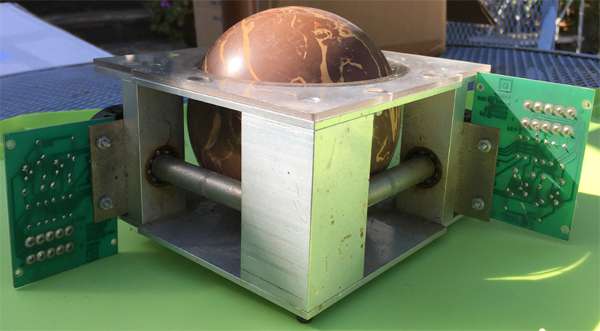
One of the original brown Trak-Balls. Photo courtesy Michael Albaugh.
This was one of the three times when I threatened to quit. The other two involved in-company arcana not relevant to players, but management (i.e. Nolan Bushnell) didn't want to spring for the TrakBall, saying a joystick would be fine. I disagreed and suggested that they find someone else to do that game.
Side note: Marble Madness was originally proposed to have a force feedback (and illuminated) trackball, and I have seen the prototypes, but again "Too costly" ruled the day, as it did with Marble Man, which I believe suffered from the switch to joysticks. Meanwhile, Jerry had made a prototype of a foot-trackball (which I have), possibly for a soccer game. The ball is a full-size bowling ball (not drilled), the "frame" plywood, and the sensor wheels the original "cup style".
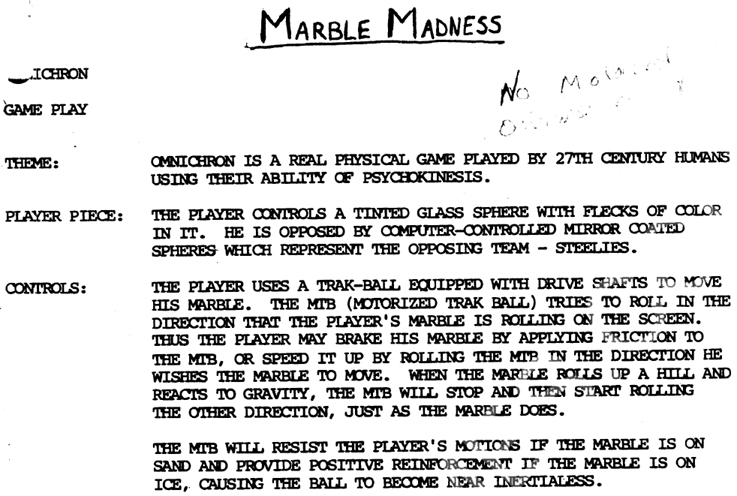
Original design specs for Marble Madness, noting the motorized Trak-Balls.
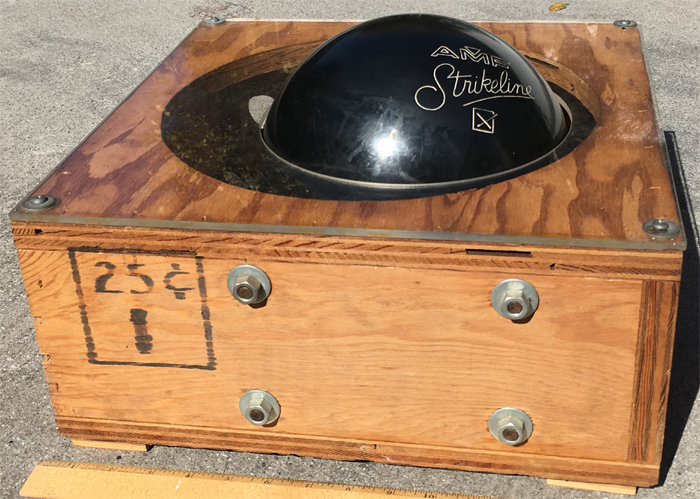
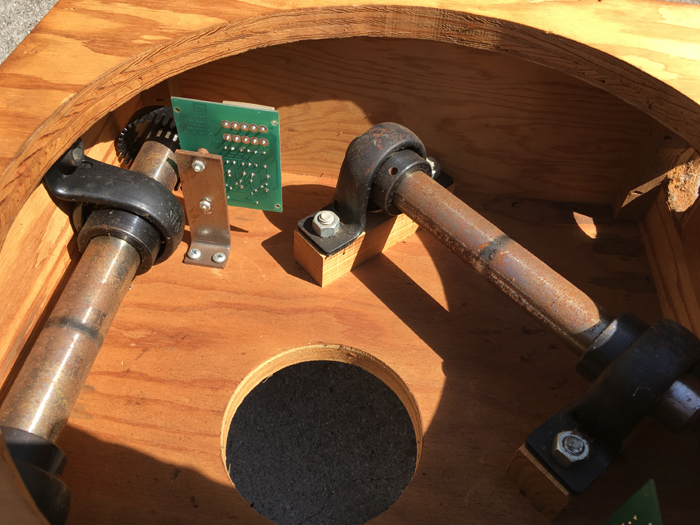
Prototype of a foot Trak-Ball controller. Photos courtesy Michael Albaugh.
Q: I don't think I've ever even seen a photo of a brown Trak-Ball. All the machines I've seen over the years had black Trak-Balls, so I'm guessing there weren't many early machines that had the brown ones.
Michael Albaugh:
Probably something like 300 to 1,000. Jerry bought them
"off the shelf", then got the black ones custom-made, IIRC. The
interesting things is that (again IIRC) he was having sticker-shock over the
cost of balls of roughly the right size, to within the moderately tight
tolerances needed, but then discovered what he referred to as "DuckPin" balls.
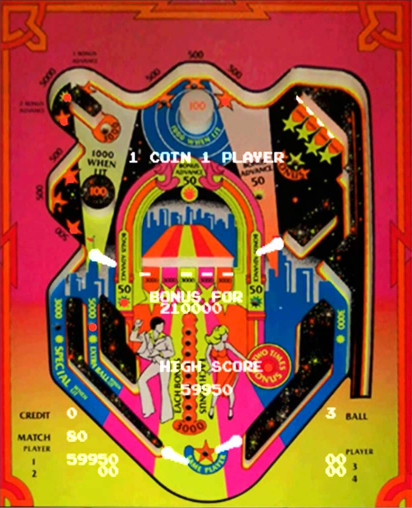
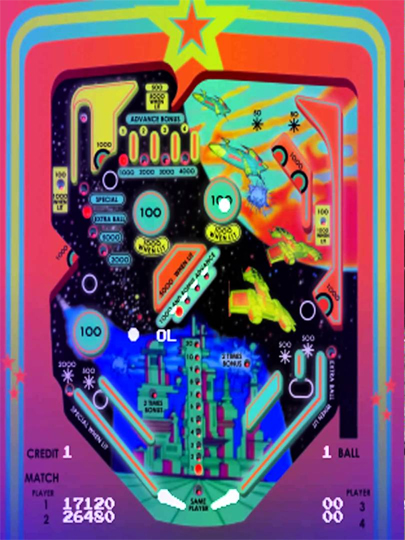
(LEFT) Atari Video Pinball; (RIGHT) Atari Solar War.
Q: Video Pinball and Solar War – Atari certainly had a love for pinball games - both video and mechanical. Video Pinball was the name of a 1977 dedicated video game system system , a 1981 VCS cartridge, and your 1979 arcade game.
Michael Albaugh: I dropped in on Dave Stubben as I was going home (he was our Team Leader and had an office near my lab bench). He was contemplating how to do a single, simple motion-object with fewer chips than usual. I started talking to him about the game it would be for, Video Pinball. As I left, I tossed off a
wacky suggestion for a minimal-hardware "ball" generator, and the next day he showed me his interpretation of what I said. I also wrote the needed software (pretentious to call it a "driver"), and possibly some other such snippets like the ball-shooter input, LED multiplexing, and the sound generator. I also may have been the one to suggest the "nudge" switch. I don’t recall which ones of those I did. As you can see, I was doing support/utility stuff for other people’s
games pretty much all along. Anyway, having piped up, I was tasked with doing the software interfaces (for the "ball" and the shooter), and possibly a rudimentary driver for the sound generator, which was a (one of the first?) programmable digital ones, as opposed to the custom analog circuits like ping-bang-boom or tapping off various sync-chain signals like Pong.
Later, I was tapped to do another game that became Solar War (after being Superman, Orion XIV, and possibly a few other names), to soak up leftover Video Pinball PCBs. We added some ROM (to allow, e.g. selectable message languages) which meant moving some of the I/O. Anyway, those changes were to go into a "new board" *if* we sold out of the initial "recycling" boards. So the software was written to be configurable for either board. This was how I got hit by
karma for suggesting the minimal-chip ball circuit. But it was fun, and Dave Theurer (IIRC) pushed that digital sound generator pretty far.
Also, it occurred to me that not everybody knows that Solar War and Orion XIV were candidate names because the underlying playfield and rules were based on Superman, which had a five and three letter spell-out for bonus.
I'm also not sure everybody knows that Ed Logg's original Video Pinball was based on Middle Earth (the pinball machine, not Hobbits etc.).
Q: I wasn't even aware that was one of Ed's games. I checked MAME, and Ed's name is the only credit attached to it.
Michael Albaugh: It was definitely his game. Like I said, I did a lot of infrastructure coding, and EE/ME kibitzing all through my career at Atari. But not every snippet of code merits a credit. Most Atari games from maybe 1979 on have some of my fingerprints on them. Ed's too. We both did stuff like diagnostics, control interfaces, etc. I did a lot of coin validation and game option setting/display (later statistics, although others like Rusty Dawe pioneered that, as well as RPM). And there was a "tools" group that I ended up being part of but existed from at least the time we got the VAXen (79-80?). The divisions among projects and official groups, and support were permeable. Warner was always messing around with even the official management structure (we grunts called it "Stirring the ant farm").

Captain Seahawk
mock-up that was produced for the banner art intended for the cabinet.
Photo courtesy of Michael Albaugh.
Q: Captain Seahawk – Another unreleased prototype. I admit I’ve never heard of this game
before. I found this page which says it was a coin-op port of a VCS game! Who’s idea was it to do that?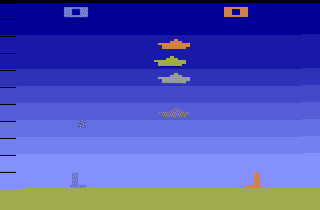
|
“TRIVIA: Captain Seahawk was basically a straight port of a 2600 game. One of the corporate guys decided instead of letting the programmers come up with game ideas, he'd tell them what to make. He said he wanted a version of game 7 from Air-Sea Battle since it was a popular part of the 2600 game. Mike told him that it's fun to play at home but wouldn't work in the arcade. Mike had to make the arcade game, anyway. So, he did a straight port, and as he expected nobody was interested in playing it in the arcade. It tested very poorly. Management decided to let the programmers design the games after that...” |
Michael Albaugh: I don't recall what bright spark thought it was a good idea. You may be aware of the most terrifying action workers can take against management: "Work to Rule". I was actually surprised to be asked about that game. One of these days I'm going to organize and document my most notable failures, not just in games.
Q: Tempest (math engine). An old Atari VAX email from you dated February 23rd, 1984 stated "The only patent I know of on the old math-box is my patent on the "multiple simultaneous use of bit fields". One from you dated February 21st, 1984 talks about a new coin routine you and Ed Logg created, and you signed it "Dr. Bizzarro Albaugh". Another email from Vickers (May 1st, 1984) mentioned you been wanting for a long time to do some sort of interactive radio play. Finally, on August 9th, 1984 was this email from you: "What's the difference between Atari and the Titanic? The Titanic had entertainment. But the Titanic's entertainment was only for first class (Tourist class was the entertainment for some of the first class passengers... but that's another story.)"
Q: The Last Starfighter (math engine). In 2007, Jim Morris posted video of the game running on YouTube. He mentions the names of a few people who worked on it (Bart Whitebook, Jack Ritter) including yourself. From my notes, I have Karl Anderson and Ted Michon attached to this as well, but I don't know how accurate that is. I also had Bart's first name as Barry.
Michael Albaugh: Bart went by the name Barry in those days. Jack did most (all?) of the actual math-box code. I did the debugger and some proof of concept code. Also some of the hardware design, along with (maybe?) Lyle Rains. Ted Michon did the bulk of the hardware design, on contract as I recall. Karl was (probably) "second Programmer".
Q: I came across a support credit for you for Atari's Road Runner (the 1984 released version). Do you recall what you contributed to it?
Michael Albaugh: Probably "the usual", although I can't quite remember if it used the anti-aliased scrolling background that Return of the Jedi used, in which case you could count my work on that, or the "fully decoded color ram" (used on E.T. among others), but I doubt that. 1984 was not a good year for me in my personal life, so I have "gaps" in memory.
I had nothing to do with the LaserDisc version, other than it possibly using some of my existing libraries. IIRC, the "Powers That Be" decided it was too expensive, so it was shelved, later to be revived as pure-CGI. I believe that later effort was a Norm Avellar and Greg Rivera effort.
Q: According to Owen Rubin, Road Runner was changed from a laserdisc-based game to one w/o it, due to the prototype's LD player repeatedly failing when out on test location.
Michael Albaugh: Sounds about right, although I feel that cost may have also had something to do with it. I was always dubious about LD games. Now, LD games are the *least* interactive games you can make (other than the gaffed "video lottery" games), but I realized that it was a branding exercise like a restaurant that uses a lot of sulfites to extend the life of their salad bar using "fresh" in the name, or how the People's Democratic Worker's Paradise is probably *not* a good place to live.
Q: Amazing how Owen Rubin was looking into the feasibility of laserdisc-based games in the late 1970s and Atari ends up being the last major manufacturer to release a laserdisc game (in 1984), with Firefox. I recently had the chance to play an original machine. The local mall had one back when it first came out, and every time I went up there, the thing was broken. So finally after 35 years I had the chance to play it, and .... what a lousy game. It plays like the tie-fighter section in Star Wars, only not nearly as fun.
Michael Albaugh: The 1983 AMOA (In New Orleans), where the embarrassing Firefox delay was, was also the site of the meeting between John Farrand and David Morse that led to the Atari/Amiga agreement and so to the cluster-f--k that left Apple the winner of the 68K wars.

4x4 prototype pinball playfield,
which was originally designed for E.T.
Q: I didn't realize some of your work was used for Star Wars: Return of the Jedi and the unreleased E.T.
Michael Albaugh: At the time, I was the Team Leader (AKA, manager) of "The Village", one of four "normal" coin-op game development teams (that is, not counting various "special projects" groups). So in a sense I "worked on" all the games from that group, and a few (i.e. Mark Cerny's Heart of Ice) that didn't get off the ground. Note that this team did two E.T.-themed games: a video and a pinball (later re-themed as 4x4, of which at least one prototype has been seen in the wild). I think management was spooked by the 2600 E.T. debacle, or maybe coming to their senses about paying huge license fees for marginal products (I later requested a return to "individual contributor" and was allowed that, with the comment, "You're not my *worst* manager" from the V.P. I reported to).
Q:
Howard Scott Warshaw commented in my interview about Lyle Rains not being
able to "complete the (arcade) game in time" (time for what, the end of 1982?).
I don't know when the home computer version of E.T. came out, but it was
definitely sometime in 1983; there's a 'coming soon' ad in the Winter 1982 issue
of Atari Connection, and a full-page ad in the Spring 1983 issue. Considering
Atari paid Spielberg an obscene amount of money to license it, I would have
expected Atari would have wanted to capitalize on it as much as possible by releasing 1
or more arcade games. I knew about 4x4 originally being the E.T. pin, but
Atari's pinball division was pretty much in chaos by that time, wasn't it?
Michael Albaugh: Lyle was definitely involved in the arcade E.T. (video
and pinball, both in my team). Robin Ziegler was the main programmer on
both arcade games.
Atari's original Pinball Division had been dead (for arguably the second time) for several years when the E.T. (later 4x4) pin was started within the mainstream coin-op group. It was also plagued by Atari micro-(mis-)management, as we were forced to use a custom chip designed by the inept-but-well-connected Atari Semiconductor group, which led to a major redesign of the PCB, plus a ritual of standing by with a fire extinguisher when the (pre-modification) prototype system was powered on. I will share no more of my experiences with that group, in following my mantra (post Atari Games V Nintendo) "Avoid Litigation".
Q: Someone else had contacted Dennis Harper, who was the principle designer for Return of the Jedi and was involved with several other arcade games (Toobin', Hydra, Primal Rage, etc.) and confirmed Robin was the programmer for the E.T. video game and also mentioned the game used the "Pixie" hardware that Lyle Rains created for Star Wars: Return of the Jedi, and that E.T. shared a similar, visual look to E.T. Dennis went on to explain the Pixie board was difficult to develop for, as it used a memory-saving technique called "pixel averaging" that saved memory but ended up requiring weeks/months of work to figure out, and if an artist wanted to changed anything with a sprite, they had to start all over again with that sprite.
Michael Albaugh: The board in question did interpolate to produce pretty much what happens when someone on a police procedural says "Enhance", but IIRC it applied only to the "Play-field" (the plane furthest from the observer), not Motion Objects (what T.I. got everybody calling "Sprites"), the middle layer, or "Alphanumerics" score and message, closest to the observer. I could be mistaken, but don't recall either M.O.s or Alphanumerics being processed by it. Perhaps some confusion with the "fully decoded palette" RAM, where every bit of the three sources/layers was fed to an address line of RAM, rather than previous practice of some sort of hardware priority decide "Z axis" (i.e. layers). This was a handy feature for, e.g. E.T.'s flashlight effect.
Q: Atari's unreleased Gremlins game also featured the player using a flashlight in the second segment (VIDEO). I wonder if E.T. was later repurposed as Gremlins? Gremlins also features the same isometric point-of-view as Return of the Jedi.
Michael Albaugh: I don't believe so, but don't know. I only recall E.T. and Jedi (and possibly also Road Runner) on that (pixel interpolation) hardware, but the history of that one is pretty "twisty".
After watching that video, I only
dimly remember the Gremlins game. The flashlight in this video does not
seem to be the same as the E.T. effect, but the video is not quite good enough
to be sure. Also, I may be confusing Gremlins with Garfield
(another game that "didn't happen"). Either (or both?) may have used a
hard-disk rather than ROM, which makes the lack of levels both more and less
explicable.
Games with an isometric POV were not uncommon, at least after Zaxxon. See Also Escape from the Planet of the Robot Monsters (I have one), but that was System 1 (post Marble Madness, and also post the giveaway of all I.P. to Tramiel père et fils.
Q: Bally pinball artist Greg Freres also mentioned their BMX pinball game (for which Greg did the backglass artwork for) originally started out based on E.T., but Bally couldn't secure the rights to it (LINK), so perhaps that prompted Atari to revive their pinball division at that time.
I never heard of Mark Cerny's "Heart of Ice" game before...
Michael Albaugh: It barely existed. It was mostly a preliminary hardware design that (in retrospect) looks a bit like the software technique used in Doom. The game play was based on a fairytale that was not familiar to me, probably of Czech origin. I think he got busy with Marble Madness, at least to the extent of working on generating anti-aliased graphics and the "moving dots" to portray rolling marbles. Also, the hardware group was not too into others doing any hardware design.
Q: As for your fomer V.P's comment, I'm starting to think every Atari 'suit' took a class on cognitive dissonance "and how best to apply it to those under you".
Michael Albaugh: You have to understand that he was as aware of corp-speak as any, and liked to play with it. One time I was grousing about some difficult task, and he said, "You know, if the job was easy, we'd get someone cheaper than you to do it", or when Williams installed a new "Head of software" who decreed that all messages in any product released after future date must be I18N, a date a few weeks later, and we had a scheduled release that would be one of the first victims. In-game message were I18N, but the decree was *all* messages, including stats and self-test. We could clearly not meet that, and I asked if we should delay the release or assume the dude was clueless and ignore it. The reply, "Just 'upcase' all the test messages. After all, everyone understands English IF YOU YELL". Maybe you had to be there, but the place was a bit "Catch 22", and you had to roll with it or give up.
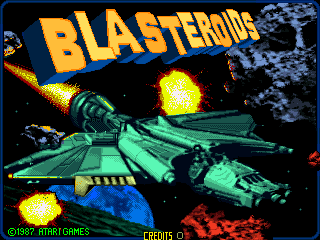 Q: Blasteroids
was the last Asteroids sequel/spinoff. What do you recall about its
development?
Q: Blasteroids
was the last Asteroids sequel/spinoff. What do you recall about its
development?
Michael Albaugh: My involvement with this was much like many other games. I did an easily-separable task to allow the game programmer (Ed Rotberg in this case) to get on with the important stuff. In this case, it involved doing the software to reuse MOs down the screen, as a cost reduction from Gauntlet hardware, which was hardware-assisted.
Q: Did you work with any graphics or sound artists? If so, do you recall who helped with what?
Michael Albaugh: Usually, at least after the early days of 1 or 2-bit deep 8x8 images. You can get an idea of my "talents" by looking at the Atari Football logo, or to a lesser extent, at the tweaks I did to the Drag Race cars. Not that I made them better, but just possible to render. At that stage, we would ask the art
department to, say, "Draw a car in 16x48 dots, in three shades of grey", and we'd get back a piece of graph paper with a drawing in a 16x48 box, but with multiple different shades per box. So other members of the team would do what they could. For example, Steve Ehret did the images for Destroyer, including a whale that was never used. We had thought that it could be an extra difficulty, getting in the way of a path from the surface to a deep sub, but then realized that
some player would actually aim for the whale, so it was dropped.
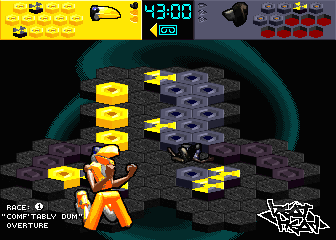
As time went on, we got distinct video graphics people, both stills and animation. Also distinct sound people. I mentioned that most early sounds were done by engineers, but as the emphasis shifted from sound effects to music and sampled sounds, the skill-sets in the sound group also expanded. Many did both music composition and sound effects, and some had major influence. IIRC Brad Fuller championed the use of FM Sound synthesis, and
blew people away with it on Marble Madness.
As for “who helped with what”, it’s a bit of a cart/horse thing there. By the time we had "professional" video graphics and sound people, I wasn't doing game design. The last game I really had creative input on, Beat Head, was actually conceived and driven by a graphics designer (Chuck Eyler) and a composer (Don Diekneite). I was the "code jockey", although I did contribute a fuzzy logic-based scheme for the computer player, which made it easier for them to
tune the gameplay. I want to be clear that I was not the original programmer for Beat Head, but "parachuted in" late in development. As I had done a lot of the infrastructure (compiler and libraries, debug support, and some of the hardware) for the game, I was an obvious choice. Bonnie Smithson (Escape from the Planet of the Robot Monsters, RoadBlasters) was the original programmer. Bonnie actually came up with the basic idea, but it was pretty
complex to use, so I revamped the process of checking and changing the tuning to make it easier for Chuck and Don to use.
Q: With your games, were there any features you would have liked to added, or any known bugs or glitches that gave you trouble (or never got resolved)?
Michael Albaugh: I've mentioned bugs in Pool Shark, Football, and Ultra Tank. Often there were hardware or software limitations that we just worked around. For example, Football has only 7 players on a side, because with 16 MOs, minus one for the ball, that's what we had available. We tried pretty hard
not to ship any bugs, because, unlike most software, we were on the hook for fixing them and distributing the updates, usually as ROMs. I tend to get a little miffed when reading about what careless slobs video game programmers were, when reading it on a "modern, professional" computer and browser that
"beach ball" or crash with alarming frequency.
One of the bugs that did not get out (because Owen spotted it, and occasionally reminds me) was a "BOOUS HEAT" message that appeared briefly in Drag Race, but so infrequently and briefly that by the time Owen called my attention to it, it had gone. It was a bug in the queuing of writes to video RAM, which was needed because CPU access to that RAM was limited.
Another Drag Race issue was that it was the first Atari game to have a Neutral gear. While it used the same shifter as previous games, they had only used switches on 1st through 3rd gear. Drag Race had 4 actual gears and neutral (another anachronism, by 1976 dragsters had limited gearboxes, and no time to stir them). Anyway, the idea was that if you missed a shift (or stayed in a low gear), you would get that "Engine Blown" ending. But a standup game could not have a
clutch pedal, so instead I gave some time between leaving one gear and getting into the next. Some in-house players (probably starting with Owen) found that you could rapidly shift in and out of 4th gear, to rev the engine above its loaded speed and dump that into the wheels when you went into 4th again. So I added sort of an integrator of partial clutch engagement, leading to "Blown Clutch".
Q: Do you remember what early or tentative titles your other games had (if any)?
Michael Albaugh: Drag Race may have been "Dragster", Football was "Monster Man", and Destroyer was "Depth Charge". Boxer/Boxing I don't remember which was first. Beat Head, one of my last, had one name throughout, but was really two very different games from the same premise. I came late to it, so I really only worked on the second version.
Q: Besides the ones already mentioned (Boxer, Captain Seahawk, and Wolf Pack), were there any games or projects that you or others worked on that ultimately never got released or even finished?
Michael Albaugh: Many. I'd have to sit down and think for quite a while to make a decent list. Of mine, maybe the most interesting would be the first-person Adventure game (cave/maze exploration and the occasional opponent). I could go to lengths about it, but the important thing was that it was quite ambitious. The feasibility study (with using a Flying Spot Scanner) did not get that far. Then Dave Sherman came up with a multiple-ellipse drawer to combine with the scalable motion objects from the original concept. That later led to Tube Chase/Tunnel-Hunt when I jumped ship, when Dan Pliskin and I got tapped to do a rush job of a substitute Math Box for Malibu (an early b&w 1st-person driving vector game), and that's when I went from doing my own games to mostly supporting others. I believe Jed Margolin was the hardware designer for the Math Box, and also that Malibu was more "state machine" than "programmed", so he probably did that too. As for the game, maybe Ed Logg?
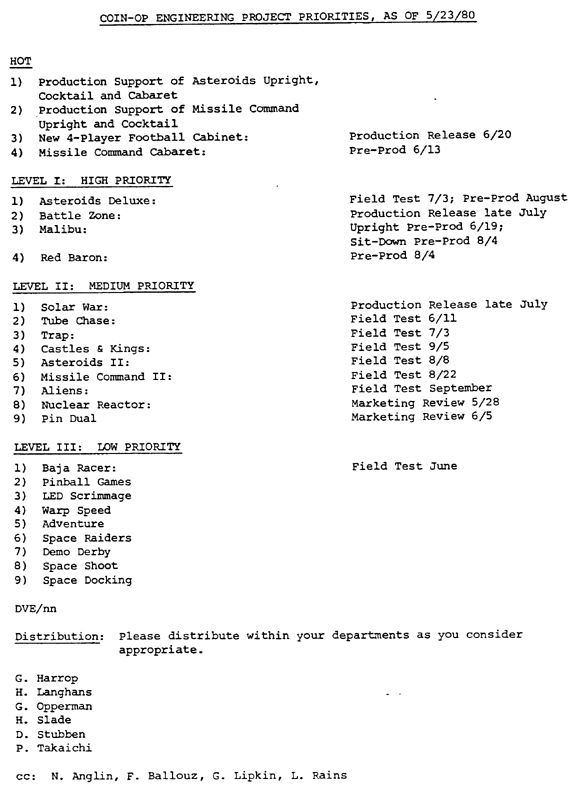
Q: I found a memo dated 5-23-80 that lists Adventure (low priority) and Malibu (high priority). I would have liked to have seen Malibu. Sounds similar to Vectorbeam's Speed Freak. What happened with it that it wasn't released?
Michael Albaugh: I suspect "the usual": not enough earnings on test to justify the cost. Roughly one-half of Ed Logg's game were released, which made him a very successful guy at getting product all the way to release. :-) The history of Atari (and I suspect any non-fly-by-night game company) is littered with "started but never released" games.
I recall Malibu including "specks" on the track, to enhance the perception of moving. Not sure if they were still in when it died.
A few comments about the memo:
Red Baron and BattleZone are on the first list, so it's definitely after Dan and I did the Math Box. Also Tube Chase argues for that, and Solar War clinches it, as I would not likely have been working on that unless the Math Box was done. But then there's Trap, which I could have sworn was well before this time (Tom Hogg's, using a spinner control to capture small "balls" in a circle with a gap in it).
I believe Pin Dual was a double-ended pinball machine, played by two players from opposite ends.
LED Scrimmage may have been a Wall Game.
Space Shoot was a minimalist shooting game by Howie Delman.
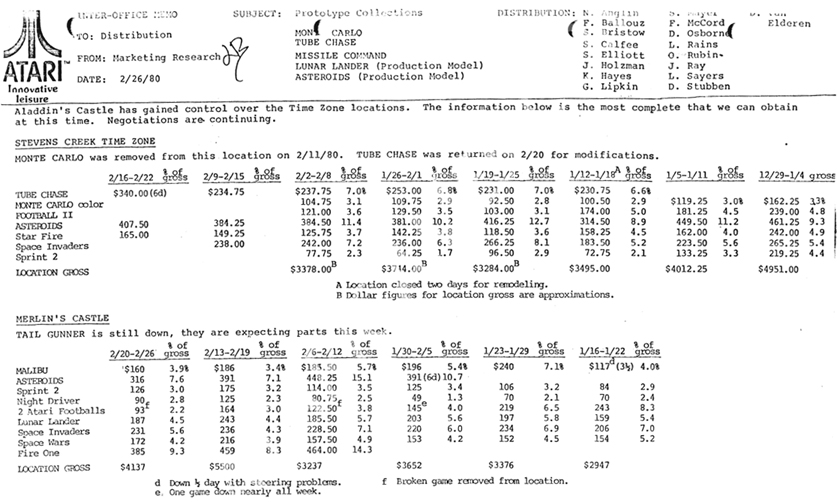
Q: I have collection reports that show Malibu was out on field test in February 1980 (3 months before that May 1980 memo), and the numbers were actually pretty good (better than Football, Night Driver, and Sprint 2 for example, which were all released). That May 1980 memo has pre-production dates for both upright (6/19) and sit-down (8/4) Malibu models, so it seems strange that the field test results would have been the reason for canceling it.
Michael Albaugh: Field test data alone is not the whole explanation. I'm sure I could sell a fleet of Tesla's if they were priced the same as Ford Fiestas. Alas, they are more expensive to make, so the question becomes, do the earnings add up to an ROI (return of investment) sufficient for an operator to shell
out for an expensive game? Malibu would have been much more expensive than Sprint 2, even if priced in inflation-adjusted dollars.
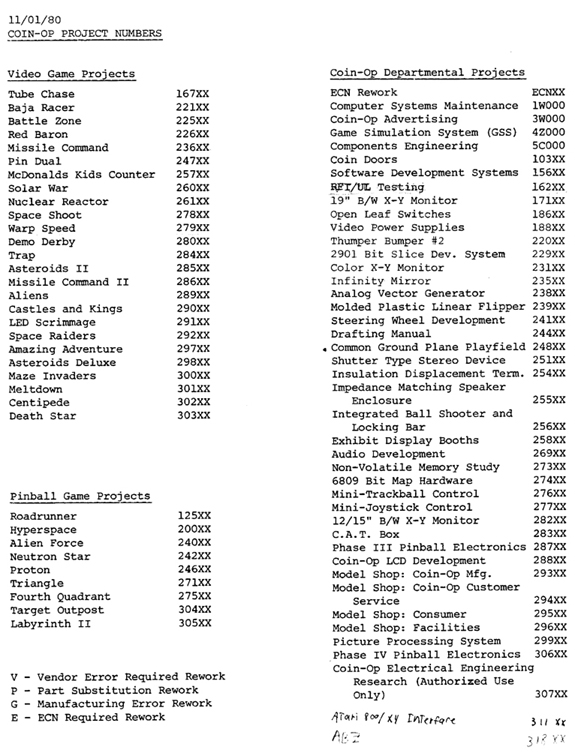
Q: I found another memo dated 11-1-80 that lists Amazing Adventure. I'm guessing both Adventure listings were your game?
Michael Albaugh: Possibly, but I do remember that the Amazing Adventure was word-play for "A Maze (ing) Adventure", that is emphasizing the maze-exploration aspect of the game, which implies that if it was "my game", it might have been after the shift from film-strip backgrounds (necessarily fixed) to digital ones
(potentially algorithmically-generated), hence more opportunity for maze exploration without getting stale. A few other comments about the memo:
McDonalds Kids Counter - contract from McDonald's. This was Owen Rubin's.
Maze Invaders - I believe this was Ed Logg's.
Castles and Kings - original title for Warlords, and that it was a (rare) conversion from VCS (Carla Meninsky) to Coin-Op (Norm Avellar and Greg Rivera, IIRC).
GSS was a project to create a "universal game prototyping system" around OMSI Pascal and a PDP-11/03. By the time it showed signs of life, the actual hardware of games had outstripped its capabilities. Fischer's Fundamental Theorem.
2901 Bit Slice... was probably the Math Box Dan and I did.
Shutter Type Stereo Device was a spinning disk in front of a vector display. Perhaps at one time it was a candidate for what became BattleZone.
Non-volatile memory study - just guessing, but maybe the beginning of storing stats and options in NVRAM? I mostly took this over from Rusty Dawe, but don't know if he started it or inherited it from someone else.
C.A.T. box -- the "universal tester" for game-PCBs, at least the ones with 8-bit CPUs and that 50-pin edge-connector near the CPU.
Picture Processing System - used by real artists to develop game image content. PDP-11/03 and some custom video hardware. I have one of the 11/03s in storage (at a friends storage unit, if he hasn't dumped it by now), but not the rest of the system. Got it at the Tramiel fire-sale.
Finally the hand-scribbled Atari 800/XY interface and ABZ. Both related to the doomed Army BattleZone project.
Quite a walk down memory lane. Need to go for a lie-down. :-)
Q: The original name for Warlords was "Kings in the Corner" (from designer Roger Hector), and according to MAME, the prototype name was indeed Castles & Kings. As for the coin-op being a port of the VCS version, Roger Hector came up with the idea for the game and presented it at a brainstorming session. The coin-op game came out in 1980 and the VCS version in 1981. I know Carla maintains the VCS version was done before the coin-op version existed, but from what others have told me over the years, both Consumer (CES) and Coin-Op often weren't very aware of what the other was doing. Carla might very well have not have been aware of a coin-op Warlords being worked on, but clearly as early as May 1980 it was.
Michael Albaugh: Not so sure. I could have sworn that when I was surprised to read that, I checked with Norm Avellar, and he said something like that "(the idea) came from upstairs". I can't seem to find that email, and the latest I can find is from 2015, from me to him, so I have no idea.
Q: Plus I would assume much more time was spent developing the coin-op compared to the VCS version. The priorities memo states Warlords was planned to go out on field test on 9-5-80. I have collection reports from 2-12-80 to 9-5-80, and none of them list it. MAME states the coin-op was released in April 1980, so I'm not sure what that's based on (mentioned in industry magazines, perhaps). That's clearly a conflict as to when it was released.
Michael Albaugh: It is pretty much futile to depend on the "collective wisdom" of the net. I just have to turn away from the bs and move on.
Q: All I can add to that is, Warlords is one of those few games that was available (and supported) both b&w (upright) and color (table) monitors. Did the Warlords table possibly come out first, and the upright later (with b&w monitors as a way to use up existing inventory of those)?
Michael Albaugh: You assume coin-op development would be longer. I'd say that the hardware itself would not even be harder, but easier. IIRC, it was essentially Centipede, but with pot inputs rather than a trackball. The Coin-Op team would have had two programmers, plus maybe an artist, and programming time would be pretty much all on gameplay, not sweating how to make the display work at all. So, *maybe* more man-hours, but probably not more wall-clock hours.
I think the lab development cabinet was upright, but wouldn't swear to it. The cocktail color monitors were not as expensive as the large, upright ones, which may have been a factor. Cocktail is a more practical format for a four-player simultaneous game.
Q: Production of ROMS for VCS games typically took 10 weeks, so figure on approx. 3 months time from when the final code is turned in for production to when the finished game is being shipped out to distributors. The approximate release date I have for the VCS version is June 1981. It's unknown how long it took Carla to program it, but typically development for 4K games was anywhere from 3-6 months. Her previous game, Dodge 'Em, was released in September 1980, so she would have started Warlords well after that May 1980 memo :)
Michael Albaugh: In Coin-Op, it was not uncommon to be in various stages of development on three titles: prepping one game for production, major development and tuning of another, and exploratory programming (and sometimes hardware) on a third. I would expect that at least some VCS programmers similarly "pipelined" a couple games, or possibly noodled around with personal projects (e.g. Morse Code, FM Music synthesis, Mastermind...) that might turn into products. OTOH, consumer management was a lot more tight-ass about these things. Calfee and I started the Forth development (that later played a substantial role, including the P.P.P. demo) as a bootleg.
Q: Occasionally, programmers would put little Easter eggs in some of their games that would reveal their name, or a message. Are there Easter eggs in any of your titles? Do you recall any fellow co-workers that did?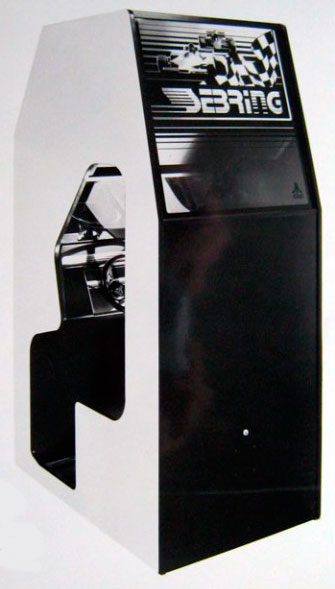
Michael Albaugh: Not sure what others did, but offhand:
Owen and I realized that we had some leftover ROM space in Sebring, and arranged for it to work (after a fashion) with the two ROM chips swapped. Most games at the time started with a brief self-test, that displayed "RAM
OK" and "ROM OK" (or, of course "RAM BAD" etc) and then either started the game attract mode or the more extensive diagnostics. If the ROMs were swapped, the message would be "RAM OK" and "ROM KO", and if the test switch was off (to go to the game) would trigger an explosion sound and show "THE ROMS ARE IN BACKWARDS".
Some of us in Engineering wanted to do a Turtle Race game, but management (in particular Frank Ballouz) were strongly opposed. Steve Calfee did a quick demo version on the Atari 800. When the "Golden Asteroids" was made and put in the lobby, the "flying saucers" became turtles.
Not exactly an Easter egg, but when I did the on-screen display for volume adjustment (I believe first for Marble Madness), I noticed that the sound board had a 5-bit logarithmic attenuator, and a MUTE bit. The display mimicked a "LED bar VU", and had 33 possible levels, so I numbered every third such that it would "Go To Eleven".
And of course the high-score tables. When we first started using non-volatile memory for storing high scores and initials, we only saved the top four (out of ten) across power cycles. These (and the fleeting 5-10) started out with the initials of various folks who had worked on the game, plus of course some "suits" (Marketing and
Management. We graciously offered to put the suits at the top). So, a completely new game would have their initials at the top, but after a few
days of play, the top four slots would have the scores and initials of actual players, while the bottom six would have the initials that were refreshed on every power cycle - ours.
As for what others did in their games, I believe the USA version of Pole Position had (briefly, I don't think it got into production) a few billboards that only appeared at speed. Or maybe that was Sebring. Maybe some little
'in' jokes, like the actual vintage computers in Escape.
Q: You were a PCB designer at Digital Telephone Systems for 4 years. Your experience from that certainly must have benefited you at Atari. At one point, Atari was developing a new division called Ataritel, which was developing video phones and other related products. Were you involved with that?
Michael Albaugh: I did one PCB design (a simple power-supply board, for schedule reasons) at Atari. My contact with AtariTel was minimal, and contentious, so move along.
Q: You had some involvement with the development of the VCS with Jay Miner and Joe Decuir, correct? What did that involve?
Michael Albaugh: Darn little. Al Alcorn didn't want his elite crew "contaminated" by contact with Coin-Op folks, but I still talked to Joe. The only part I can recall playing was in debugging the test-setup for the first-silicon TIA. This was a lashup based on a KIM-1, and they had a "Heisenbug". The TIA registers could be read and written from the debugger, but not (reliably) by running code. I suggested that the issue may be the chip-select setup time being marginal, and so it was.
Q: The same book I referenced earlier mentions you were involved with the Atari 400/800’s ANTIC chip design, as well as the Serial I/O port. Is that true?
Michael Albaugh: Not really. I mentioned some things to Jay and Joe during unofficial conversations, and some of these got into the ANTIC - in particular "data chaining" and "Display List interrupt". They were early in the definition of what the ANTIC "instructions" would be, and I don't remember who thought of the JMP, but I
said it reminded me of the "Transfer In Channel" instruction on an IBM Channel, and that reminded me of data chaining (where an I/O operation can inherit the data address from a previous one, or in ANTIC, where a Mode can specify a data address, or inherit it from the previous one) and Interrupts when a particular channel instruction was fetched. I also strongly urged them to fight for the 800 being able to handle both upper and lower case in character modes. Management was
apparently of the opinion that since the Apple ][ had only upper case (until later, or by using graphics modes), Atari didn’t need lower case, either.
On SIO I mentioned a potential problem, which became a real problem later, but was dismissed. So, I had no actual influence there. The SIO problem manifested as repeated strings on newer printers. A bad interaction between:
1) No packet numbering.
2) Bad instruction ordering in the SIO send routine, leading to a race condition.
3) Slightly different delay between packet reception and sending ACK on different printers.
Q: DLIs were a feature of the ANTIC chip which basically made the system what it is and enabled games to have dozens of colors on the screen!
You mentioned writing the 400/800 Point-of-Purchase demo. Was this the Atari E.R.I.C. (Electronic Retail Information Center) POP (Point Of Purchase) store kiosk laserdisc-based machine? These were used on location to educate use of and promote sales of the Atari 400/800 home computers.
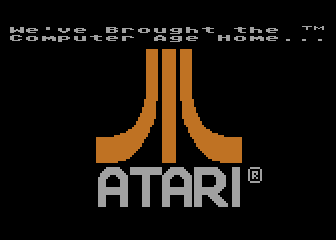 Michael Albaugh: Nope. Not close. I did a floppy disk-based Point Of Purchase
demo for the 800, and a slightly-different cartridge one for the 400 (Ed.: It's called the In-Store Demonstration Program). Of possible interest:
Michael Albaugh: Nope. Not close. I did a floppy disk-based Point Of Purchase
demo for the 800, and a slightly-different cartridge one for the 400 (Ed.: It's called the In-Store Demonstration Program). Of possible interest:
1) I made the disk capable of cloning itself if you held down a button while booting. Originally, Management was appalled ("We don't want people stealing this!"). I managed to convince them that having stores able to make multiple copies
(of what are now called "influencers") and pass them out to friends who could continue to pass them around, was actually more like free advertising, so they let me do it.
2) The cartridge was hand-carried to CES. It was as far as I know the first 16K cartridge, or at least the first to leave Atari. The label looked approximately correct, but was hand-done by a graphic artist friend.
3) The background music ("Disco Dirge") was written by Dan Pliskin.
Btw, after seeing the Atarimania page you referenced, I noticed it has a couple errors, and some ego-bruising comments. All part of the job... I did find it interesting that the top commenter thought that a lot of content had been trimmed from the disk version to make the cart, and that (somehow? Magically?) the default name had changed in the cart to "Neil", as opposed to the more logical explanation that the net version of the disk had been modified. One despairs for the Yoof of Today. Of course I also wonder if the maintainer of that site actually believes someone tasked with producing a commercial software project, using 16K bytes, would write it in "Machine Language", rather than Assembly or (as it actually was) Forth (Ed.: Michael talked more about this in his Antic Podcast interview. In summary, he temporarily switched departments with Rick Maurer created this because it was a 'separable' task and wouldn't interfere with anything other projects in Consumer).
Q: You mentioned doing the initial development of an in-house software development system for NES, running on an Atari ST. I’m guessing this was for Tengen, correct?
Michael Albaugh: Yes. It was basically an adaptation of the "Blue Box/White Box" Coin-Op development system, with the ST serving as the Blue Box. After I got a Proof of Concept running, the task was sent over to Tengen, along with the 1040 ST that was my personal property. I never got it back or was paid for it *sigh*. I also never got back the Famicom keyboard that was used in the Tetris case.
Q: The work you did to reverse-engineering the NES lockout chip was for the Tengen branch of Atari, correct? I know Nintendo sued Tengen over it and the courts agreed with Nintendo, forcing Tengen to recall the games they had released. I recall the games actually contained some of Nintendo’s code, which is how they ended up losing. What do you recall about it?
It sounds like it's a similar situation to what I've heard about the lawsuit between Atari and Activision. By most accounts, Activision was victorious and it opened the way for other 3rd-party software companies. What isn't widely reported (and from what little I could find) is that Activision settled with Atari and ended up paying them a royalty/fee per cartridge they sold. I've asked David Crane about it, but his response was much the same - due to terms of the settlement, he's unable to talk about it.
Michael Albaugh: I can only answer in vague and well-publicized terms. Lawsuits went both ways. It is my understanding that the terms of the settlement prohibit disclosure of the terms of the settlement (first rule of fight club). I can confidently state that nearly everything that has been published about that case is
false, but since "those that know can't tell, and those that tell don't know", there is little I can say, and less that I can say in public without risking further problems. For years I had two words clipped from a newspaper headline taped to the top of my monitor: "Avoid Litigation".
BTW: I just spent (wasted?) an hour or so trying to find a web-page that discussed the lockout chip, and how it worked, and how to defeat it. That page is distinguished by using the code-name "Acacia", which was only used in the transfer of the details of operation to the clean-room coders, and of course to refer to the chip in the legal proceedings. So at least someone violated the contract with Tengen or the court order. Anyway, in the process I came across an absolute
mountain of misinformation, basically repeating the Nintendo version of the case. Seems like only one side can resist violating the seal, or is it that it's only a problem if you tell the truth, not if you lie?
Q: What was the project you were involved with in debugging the Sony disk driver for Primal Rage? Was this for the Sony Playstation?
Michael Albaugh: Yes. We wanted to use a hard drive instead of a CD-ROM. The Sony-supplied code had bugs, and their debug tools would not allow you to display the contents of their top-secret code, but would allow you to copy blocks of memory, so I copied it to an area of memory that the tools would look at. I don't recall the exact bug, but I do recall that the disk driver code in the area looked very much like it had been written in Assembly (not the sort of idiomatic code that a compiler of the day would create), and "too clever by half". I wrote a simple test version in C, from which the default compiler produced "tighter" code than the original, and as a bonus, it lacked the bug.
Q: You mentioned writing the infrastructure code for CoJag, a coin-op platform using the AtariCorp Jaguar chipset. There were a few games that used this (link):
3 On 3 Basketball
Area 51
Area 51 : Maximum Force Duo
Fishin' Frenzy
Freeze
Maximum Force
Vicious Circle
Were there any others?
Michael Albaugh: Not that I know of. By the time Area 51 Site 4 came out, it was on a "baby AT" PC motherboard.
Q: What were some of your experiences working at Atari? Do you have any stories or anecdotes from those days that you relate?
Michael Albaugh: That would make a much longer interview. 24+ years can’t be compressed that much, even if we filter for shenanigans. I suppose the Recreational Pharmaceuticals memos and the prima donna tee-shirt would be top of the list of what I did. There was a certain amount of pranking going on. We changed one manager’s login to execute a 6502 emulator running MSFT BASIC, and one programmer’s login to ask “Are you sure?” when he typed “DIR”. If you are looking for heartwarming stories of kindness and fortitude, I’ll have to think about it.
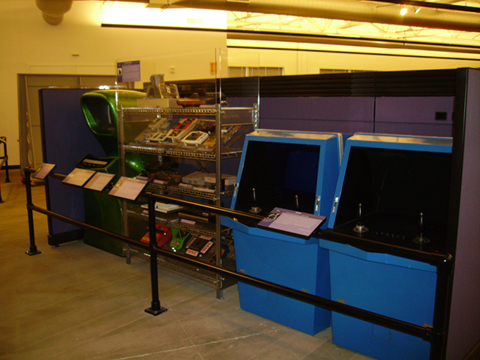
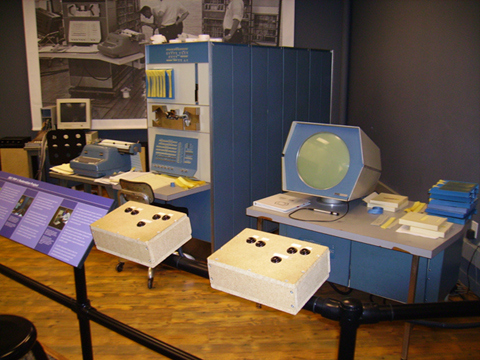
Photos from the Computer History Museum.
Q: You now volunteer at the Computer History Museum in Mountain View, CA, which I had the pleasure of visiting years ago. How did you happen to get involved with that?
Michael Albaugh: A UseNet friend got me into volunteering there, back when “there” was a Quonset hut at the Naval Air station. I never outgrew it.
Q: Do you still own any of your games, either as a keepsake, or to show friends or family?
Michael Albaugh: I have a Solar War (one of 5 or so), and own a Boxer, but it’s elsewhere “being repaired” (for over five years). Also an Escape and a Gretsky Hockey, although I did little on either. And the POP demos. Some still have followings. For example, The Last Starfighter (I worked on the math-box) has at least one devoted fan.
Q: Which of your titles are your favorite, and what types of games in general? What’s your preferred platform for gaming?
Michael Albaugh: I’m not really a gamer. I do enjoy pinball, but got rid of my two machines (both protos) when they got to be just too much work.
Q: Have you stayed in touch with any of your former co-workers?
Michael Albaugh: Several. There was recently a (mostly Coin-Op) reunion in a local park.
Q: What are your thoughts on how the industry has evolved?
Michael Albaugh: Cliche, but it went from a craft with small, tight groups, like a local theater company, to more like Hollywood, with giant teams and management structure that would make the Pentagon swoon. And of course a real hit-driven, cautious agenda. In short, no thanks. There are still interesting things going in the demo scene, indie games, and interactive fiction, though.
| GAME | SYSTEM | COMPANY | STATUS |
| Pool Shark | arcade | Atari | released |
| Boxer | arcade | Atari | unreleased |
| Drag Race | arcade | Atari (Kee Games) | released |
| Destroyer | arcade | Atari | released |
| Tournament Table | arcade | Atari | released |
| Ultra Tank | arcade | Atari (Kee Games) | released |
| Atari Football | arcade | Atari | released |
| Video Pinball | arcade | Atari | released |
| Solar War | arcade | Atari | released |
| Captain Seahawk | arcade | Atari | unreleased |
| Amazing Adventure | arcade | Atari | not completed |
| Malibu (Math Box) | arcade | Atari | unreleased |
| Red Baron (Math Box) | arcade | Atari | released |
| Battlezone (Math Box) | arcade | Atari | released |
| Tempest (Math Box) | arcade | Atari | released |
| In-Store Demonstration Program | Atari 400/800 | Atari | released |
| E.T. | arcade | Atari | not completed |
| Star Wars: Return of the Jedi | arcade | Atari | released |
| The Last Starfighter (Math Box) | arcade | Atari | not completed |
| Air Race (design and programming) | arcade | Atari Games | not completed |
| Marble Madness (software support) | arcade | Atari Games | released |
| Peter Pack Rat (software support) | arcade | Atari Games | released |
| Road Runner (support) | arcade | Atari Games | released |
| RoadBlasters (hardware engineer) | arcade | Atari Games | released |
| Blasteroids (software support) | arcade | Atari Games | released |
| Hard Drivin' (additional programming) | arcade | Atari Games | released |
| Pit-Fighter (support programmer) | arcade | Atari Games | released |
| Shuuz (design and programming) | arcade | Atari Games | released |
| Skull & Crossbones (special thanks to) | arcade | Atari Games | released |
| Skull & Crossbones (technical support) | NES | Tengen | released |
| Rampart (software support) | arcade | Atari Games | released |
| Steel Talons (technical support) | arcade | Atari Games | released |
| Space Lords (special support) | arcade | Atari Games | released |
| Beat Head | arcade | Atari Games | unreleased |
| T-Mek (systems support) | arcade | Atari Games | released |
| Mace - The Dark Age (support programmer) | arcade | Atari Games | released |
| Wayne Gretsky's 3-D Hockey (support programmer) | arcade | Atari Games | released |
| Area 51: Maximum Force | arcade | Atari Games | unreleased |
| Area 51: Site 4 | arcade | Atari Games | released |
| California Speed (systems support) | arcade | Atari Games | released |
| Fishin' Frenzy (software) | arcade | Time Warner Interactive | unreleased |
| Gauntlet Legends (additional programming) | arcade | Atari Games | released |
| Vapor TRX (programming) | arcade | Atari Games | released |